March 7, 2011 | BITE: My Journal
Socarrat’s New Crunch

Pescadas e mariscos paella below, lamb and eggplant version above. Photo: Steven Richter I liked the monomania of Socarrat Paella Bar in Chelsea. There was something sexy and romantic sitting across from the Road Food Warrior at the long communal table in the narrow space on W.19th Street, watching owner Lolo Manso scraping the stuck-on rice rubble from the bottom of our shared paella pan…piling that crunchy good stuff on our plates. Every once in a while since, making a critic’s rounds, I would hunger for that paella. But the place did not book ahead. Occasionally I would call, anonymously, of course, and ask if there was any hope. There was always a cluster of devotees pawing the sidewalk. I was warned.
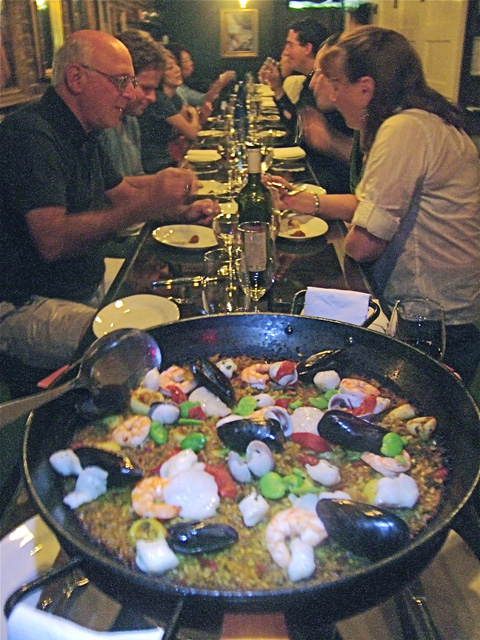
A crowd usually waits for seats at the communal table in Chelsea. Photo: Steven Richter
So I was excited when Manso announced a new, larger Socarrat would open on Mulberry Street. Though that’s definitely not my ‘hood, reservations would be honored. I let a few blizzards and a gig out of town keep me away. Finally, I found it Saturday night before last – a beacon of life across the street from the dark desolation of stalled construction. Inside, a man is holding a velvet wind baffle tight to protect the twos and threes at a tall communal table as we enter. There are iron gates and lacquered cream cupboards like those uptown.
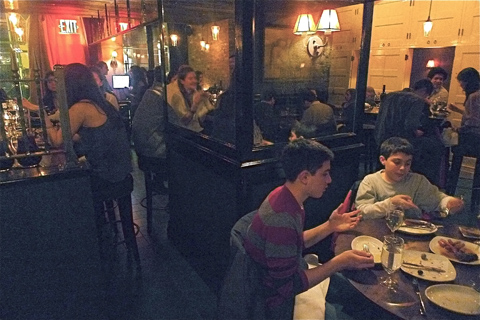
More space allows reservations at new Socarrat Nolita. Photo: Steven Richter
I imagine I am already hearing the tat-a-tat of spoons scraping iron paella pans. But there is a defined prologue here: I need to catch up with our friends, already settled into a tight round booth just big enough for four, glasses of red for all and a few tapas. Pulling out my flashlight to study the starter possibilities in the dim – I want everything. Scallop carpaccio for sure and sizzling shrimp with garlic. I might try a few montaditos, (individual toasts with toppings at $3 each), new at this location: gambas with piquillo pepper aioli, pan tomaca with Serrano ham, goat cheese and anchovies. I could easily make a meal of Spanish beginnings. I suppose there are carbo-phobes in the house doing just that. But for most socarrat fans it’s about the paella. Or even the rich fideuas, seafood in crispy noodles. And I remember how generous a paella for two can be.
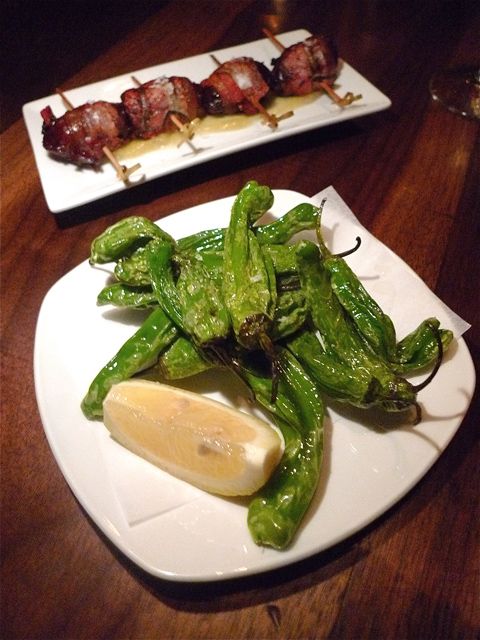
The divine stuffed dates and the Russian roulette of shishitos. Photo: Steven Richter
“Let’s each choose one tapa,” I suggest. So we’re eyeing the glossy, thin skinned, grilled shishito peppers, knowing its peculiarity, that one in five will be fiery hot, then diving. Bean stew with sausage and not very good bread to scoop it up is not my choice, but I find myself finishing off the last savory bean. And we’re sharing a swoon over the plump marcona-almond stuffed dates wrapped in excellent bacon, a relic of my own inevitable 60’s cocktail canapé, but so much better.
By the time I realize that Steven’s cuttlefish à la plancha has not appeared, it’s too late to alert our server Thomas, who is newly arrived from Newcastle, he confides, when we ask about that accent. And he’s still fresh enough to admit he’s not all that familiar with everything on the menu. He hasn’t been in town long enough to acquire irony, hip or disdain, but he does know his wines. He recommends a Tempranillo from Rioja, Cerro Anon Crianza for $52, a red that suits me.
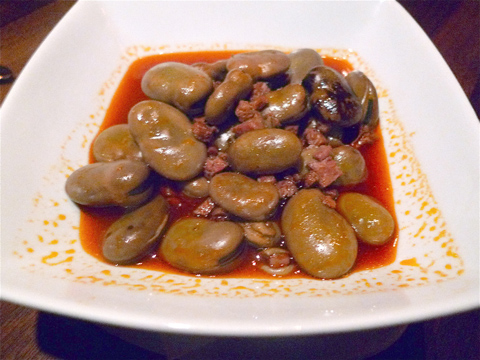
Fabas frescas with butifarra and sobrasada sausage. Photo: Steven Richter
Now he’s setting up trivets side by side for the hot paella pans – pescada and mariscos looking gorgeous for us, and the Cordero, lamb with Japanese eggplant and pine nuts, a study in brown for our friends. (Each paella is priced per person, $22 to $28, for lobster with langoustines, calamari, cockles and bass). “Now you need to let them rest,” says Thomas. Time for Steven to grab these photos and the rice to form into crusty socarrat, “the seductive caramelization that forms on the bottom layer of a perfect paella” as defined on the menu.
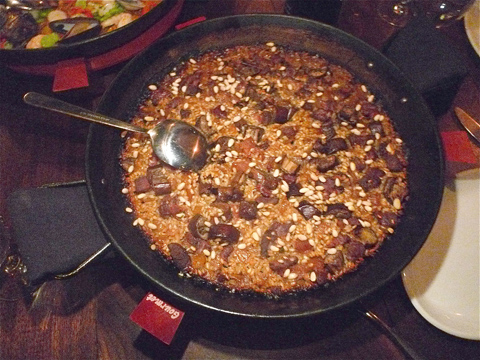
The rich ooze of lamb fat gives the cordero paella an even lusher crust. Photo: Steven Richter
He returns to serve us, scraping from the bottom up - socarrat is the name of the game. For me, paella is seafood, though I’ve had it with snails, chorizo, overcooked chicken or rabbit, and shriveled peas. Tonight the cod is delicately cooked, the tender shrimp, smallish but not pee-wees, mussels, squid and scallops are all carefully cooked. The crunch is more lush than remembered. But the crusted rice of the Cordero is a revelation. The extra sap of lamb fat and ooze of eggplant crisps the grains with a sublime meaty liqueur. As we reach out to scrape away on our own, Thomas spies us and skates up to take over. “You have to really dig hard,” he says, digging hard. In that moment when a fog of too-muchness is setting in and our guy is off again serving elsewhere, the manager himself takes over the scraping. “Yes?” he asks, as we hesitate.
“Well, if you insist.” As our friends watch, I finish the last of the lamb stickings and ask for the seafood leftovers to take home. No way any of us can handle dessert -- chocolate beignets, “egg toast” with vanilla ice cream or espresso flan -- though the crèma Catalana, inspiration for Le Cirque’s crème brûlée, calls out to me. Behind us as we emerge into the frigid night, someone is clutching the velvet curtain.
284 Mulberry Street between Houston and Prince. 212 219 0101. Dinner only Sunday to Thursday 6 to 11 pm, Friday and Saturday till 11:30 pm.
Carpetbaggers Carry Knives at Bar Basque
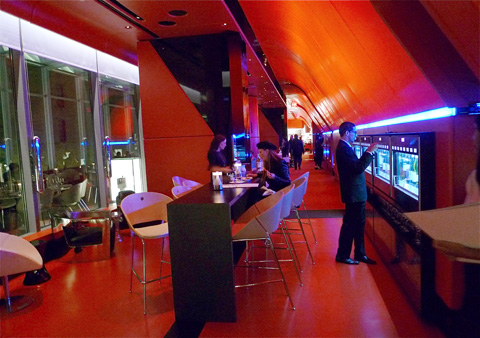
I like the red room – it matches tonight’s tuna -- but Steven hates it. Photo: Steven Richter
It’s gutsy and extravagant for a freshly hatched restaurant to import a guest chef every other month. Especially one with a “modern minimalist palette” from Basque country. Terry Zarikian, creative partner at Bar Basque, had the dream. With his usual exuberant optimism, Jeffrey Chodorow agreed to finance it.
Now we are assembled for a seven course tasting by Aitor Basabe, guest chef for March, from Arbola-Gaña, in an upper floor wing of the Bilboa Fine Arts Museum. It’s a preview benefiting Citymeals-on-Wheels. (I’m the board chair. Chodorow is a long time supporter. He advertises on my web site. Enough caveats for the ethics police?)
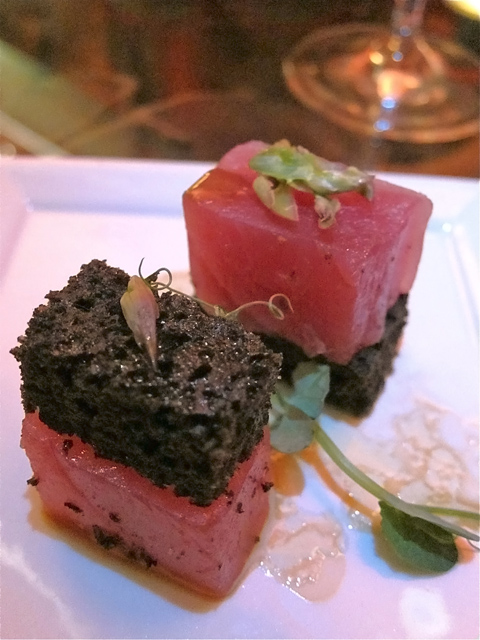
Tuna crudo with olive bread echoes the color scheme at Bar Basque. Photo: Gael Greene
Given my passionate disdain for Frankenfood and the simmering beakers of Ferran Adria’s homeboy disciples, I have mixed emotions: happy to have the money, guys, but do I really need vinegar ice cream?
Can’t be I’ve mellowed. I spy coal salt and cocoa dirt with hay on the menu. Must be Basabe is mellow enough for both of us. However he coagulates his bacon crisps or thickens the jabugo ham gelée, they make an amusing amuse, and his “Tomato Study” – heirloom tomato cream, tomato sponge and green tomato oil, has me marveling at the pow. (He brought his own sun-dried tomato powder with him.)

Sustainable Chilean sea bass from guest chef Basabe’s tasting menu. Photo: Gael Greene
A thick cube of tuna seems a bit tough (cut on the wrong grain perhaps) topped with crumbly black olive bread and asparagus tips, but I give it points for couturier style, matching the restaurant’s red-and-black theme. I might have added a tapenade filling myself to make it even sexier. Following such elegance, a creamy porridge of Calasparra rice wondrously perfumed with mushrooms, Idizabal sheep’s milk cheese and green garlic, seems even more rustic.
“Sustainable” Chilean sea bass, the menu promises. It's rare at the heart, voluptuous on the tongue, served with plump mussels and a pleasant enough green emulsion. But I’m curious. When did Chilean sea bass get “sustainable?” Apparently there is one shipper with that rating. “It cost a fortune,” the restaurant’s gifted resident chef Yuhi Fujinaga confides. “But Basabe insisted it must be Chilean sea bass. I worked with Ed Brown at Restaurant 81 and I use his fishmonger, so you can be sure it came from where it says it came from.”
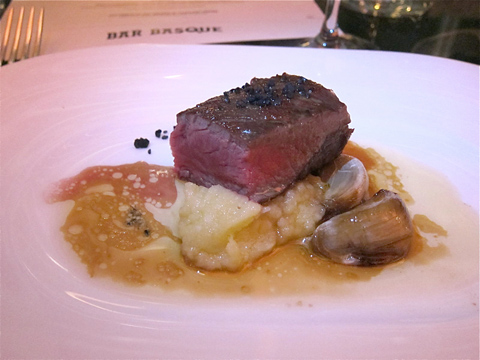
A chunk of beef is sprinkled with Hawaiian black salt. Photo: Gael Greene
The small rectangular chunk of New York strip that follows is marvelous, rare and meaty, oozing juice. Coal salt, as the menu notes, refers to a sprinkling of Hawaiian black sea salt, Fujinaga tells me later. Given all that’s come before and the generous pours of Verdejo and rich Tempranillos, matched to each course, that small cut is exactly enough.
Candied pineapple in what looks like a spun sugar wrap –“piña colada en crystal” - is sweeter than a classic palate freshener, but pretty as a prom dress. And I love pineapple anything. The “cocoa dirt” under peach escabeche ice cream turns out to be poetic license. Whether or not you’ll find Balsamic vinegar ice cream on a Manchego chip more than interesting, I can’t predict. After more Rioja than I normally drink, my critical fences may be tilting. I think I like it.
839 Sixth Avenue between 29th and 30th Street. 646 600 7150. Sunday through Thursday 6 to 11 pm. Friday and Saturday till midnight. Breakfast 7 to 11 am. Brunch Saturday and Sunday 12-4 pm.
|
|